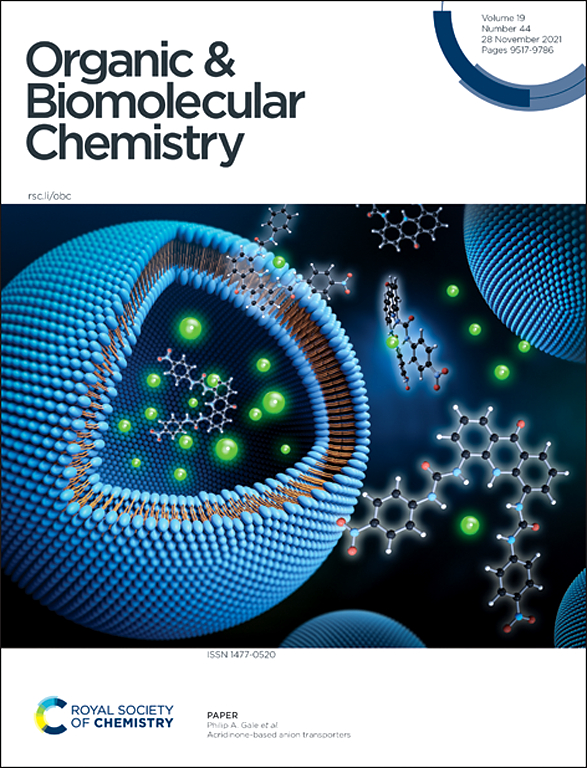使用多酚钝化纳米碳破坏l-苯丙氨酸的纤维组装作为治疗苯丙酮尿的潜在策略。
IF 2.7
3区 化学
Q1 CHEMISTRY, ORGANIC
引用次数: 0
摘要
苯丙酮尿症(PKU)的病理表现之一是芳香氨基酸l -苯丙氨酸在病理浓度下形成纤维状组装体。作为一种可能的治疗PKU的策略,我们引入了一种用多酚没食子酸(CNPGA)钝化的纳米碳系统,该系统具有破坏和抑制纤维组合形成的能力。以蔗糖和没食子酸水溶液为原料,采用微波辅助一锅法快速制备了CNPGA,并用UV-Vis、FT-IR、XRD、XPS、TEM、zeta电位和DLS对其进行了表征。利用硫黄素T (ThT)检测cnpga介导的l -苯丙氨酸原纤维的抑制和破坏。用圆二色光谱分析了CNPGA处理后原纤维构象的变化。利用扫描电镜对纤维束断裂进行了可视化分析。最后,在人类表皮角质形成细胞系HaCaT和非洲绿猴肾细胞系Vero两种正常细胞系中评价了CNPGA的生物相容性。本文章由计算机程序翻译,如有差异,请以英文原文为准。

Disruption of fibrillar assemblies of l-phenylalanine using polyphenol-passivated nanocarbon as a potential therapeutic strategy against phenylketonuria†
One of the pathological manifestations of phenylketonuria (PKU) is the formation of fibrillar assemblies of the aromatic amino acid l-phenylalanine at pathological concentrations. As a possible therapeutic strategy for PKU, we introduce a nanocarbon system passivated with polyphenol gallic acid (CNPGA), which has the ability to disrupt and inhibit the formation of fibrillar assemblies. The CNPGA was prepared using a rapid and facile microwave-assisted one-pot method from an aqueous solution of sucrose and gallic acid and fully characterized using UV-Vis, FT-IR, XRD, XPS, TEM, zeta potential and DLS measurements. The CNPGA-mediated inhibition and disruption of l-phenylalanine fibrils was examined using a thioflavin T (ThT) assay. The change in the conformation of the fibrils upon CNPGA treatment was assessed by means of circular dichroism spectroscopy. Visual analysis of the rupture of fibrillar assemblies was performed using SEM. Finally, the biocompatibility of CNPGA was evaluated in two normal cell lines, HaCaT (human epidermal keratinocyte cell line) and Vero (African green monkey kidney cell line) cells.
求助全文
通过发布文献求助,成功后即可免费获取论文全文。
去求助
来源期刊

Organic & Biomolecular Chemistry
化学-有机化学
CiteScore
5.50
自引率
9.40%
发文量
1056
审稿时长
1.3 months
期刊介绍:
Organic & Biomolecular Chemistry is an international journal using integrated research in chemistry-organic chemistry. Founded in 2003 by the Royal Society of Chemistry, the journal is published in Semimonthly issues and has been indexed by SCIE, a leading international database. The journal focuses on the key research and cutting-edge progress in the field of chemistry-organic chemistry, publishes and reports the research results in this field in a timely manner, and is committed to becoming a window and platform for rapid academic exchanges among peers in this field. The journal's impact factor in 2023 is 2.9, and its CiteScore is 5.5.
 求助内容:
求助内容: 应助结果提醒方式:
应助结果提醒方式:


